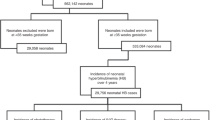Abstract
This study aimed to evaluate the frequency of the main risk factors for severe neonatal hyperbilirubinemia, to determine the incidence of exchange transfusion (ET) in the Autonomous Province of Vojvodina (the northern part of Serbia) and to describe the experience with ET performed in premature and term infants during the past 17 years. We performed a retrospective data analysis of 398 newborn infants who underwent a double volume ET from 1997 to 2013. During the 17 year study period, a decreasing incidence of ET, expressed per thousand newborns, was observed. A total of 468 double volume ET were performed: 328 (82.4 %) infants had one treatment and 70 (17.6 %) had repeated treatments. A total of 262,830 mLs of blood were transfused, an average of 660 mLs per child. There were 221 male and 177 female infants, with a sex ratio 1.25:1. The frequencies of risk factors for developing hyperbilirubinemia were as follows: (1) 38 % RhD incompatibility; (2) 38 % ABO incompatibility (26 % group A infant of group O mother, 12 % group B infant of group O mother); (3) 7 % low birth weight/preterm birth; (4) 17 % other factors. Risk factors for neurotoxicity were identified in 56.3 % of infants. No deaths or complications were reported arising from the treatment. ABO and Rh incompatibilities were found to be the main risk factors for severe neonatal hyperbilirubinemia in Vojvodina. Exchange transfusion, used as therapy for severe hyperbilirubinemia, trended downwards over the period of this study.


Similar content being viewed by others
Abbreviations
- EBT:
-
Exchange blood transfusion
- HBFN:
-
Hemolytic disease of the fetus and newborn
- RBC:
-
Red blood cell
- BTIV:
-
Blood Transfusion Institute for Vojvodina
- RhD:
-
Rhesus blood group, D antigen
- ABO:
-
ABO blood group
- ISO:
-
International Organization for Standardization
- IAT:
-
Indirect antiglobulin test
- DAT:
-
Direct antiglobulin test
- BW:
-
Body weight
- CPD:
-
Anticoagulant citrate phosphate dextrose
- CPDA1:
-
Anticoagulant citrate phosphate dextrose adenine
- G6PD:
-
Glucose 6 phosphate dehydrogenase enzyme
References
Ahlfors C, Wennberg R, Ostrow D, Tiribelli C (2009) Unbound (Free) bilirubin: improving the paradigm for evaluating neonatal jaundice. Clin Chem 55(7):1288–1299
Bjerre JV, Petersen JR, Ebbesen F (2008) Surveillance of extreme hyperbilirubinaemia in Denmark. A method to identify the newborn infants. Acta Paediatr 97:1030–1034
Burke BL, Robbins JM, Bird TM, Hobbs CA, Nesmith C, Tilford JM (2009) Trends in hospitalizations for neonatal jaundice and kernicterus in the United States, 1988–2005. Pediatrics 123:524–532
Thayyil S, Milligan D (2006) Single versus double volume exchange transfusion in jaundiced newborn infants. Cochrane Database of Systematic Reviews Issue 4 Art. No. CD004592
Chen HN, Lee ML, Tsao LY (2008) Exchange transfusion using peripheral vessels is safe and effective in newborn infants. Pediatrics 122(4):905–910
Murray N, Roberts I (2007) Haemolytic disease of the newborn. Arch Dis Child Fetal Neonatal 92:83–88
Geaghan SM (2011) Diagnostic laboratory technologies for the fetus and neonate with isoimmunization. Semin Perinatol 35(3):148–154
Smits-Wintjens VEHJ, Walther FJ, Lopriore E (2008) Rhesus haemolytic disease of the newborn: postnatal management, associated morbidity and long-term outcome. Semin Fetal Neonatal Med 13(4):265–271
Rath ME, Smits-Wintjens VE, Lindenburg I, Brand A, Oepkes D, Walther FJ, Lopriore E (2010) Top-up transfusions in neonates with Rh hemolytic disease in relation to exchange transfusions. Vox Sang 99:65–70
Smits-Wintjens VE, Walther FJ, Rath ME, Lindenburg I, te Pas A, Kramer C, Oepkes D, Brand A, Lopriore E (2011) Intravenous immunoglobulin in neonates with rhesus hemolytic disease: a randomized controlled trial. Pediatrics 127(4):680–686
Murki S, Kumar P (2011) Blood exchange transfusion for infants with severe neonatal hyperbilirubinemia. Semin Perinatol 35(3):175–184
Statistical Office of the Republic of Serbia (2012) Natural changes of population in the Republic of Serbia, 1961–2010, Belgrade
Institute of Public health of Serbia “Dr Milan Jovanovic Batut” (2013) Health statistical yearbook of Republic of Serbia 2012, Belgrade
Neonatal transfusion (2002) In: The clinical use of blood—handbook. World Health Organization, Blood Transfusion Safety, Geneva, p 222
Gartner L (1980) Chapter 6: neonatal jaundice A selected retrospective. In: Smith G, Vidyasagar D (eds) Historical review and recent advances in neonatal and perinatal medicine. Mead Johnson Nutritional Division, Chicago
Lopriore E, Rath ME, Liley H, Smits-Wintjens VE (2013) Improving the management and outcome in haemolytic disease of the foetus and newborn. Blood Transfus 11(4):484–486
Owa JA, Ogunlesi T (2009) Why we are still doing so many exchange blood transfusion for neonatal jaundice in Nigeria. World J Pediatr 5(1):51–55
Bulbul A, Okan FF, Unsur EK, Nuhoglu A (2011) Adverse events associated with exchange transfusion and etiology of severe hyperbilirubinemia in near-term and term newborns. Turk J Med Sci 41(1):93–100
Slusher T, Zipursky A, Bhutani V (2011) A global need for affordable neonatal jaundice technologies. Semin Perinatol 35(3):185–191
Zuppa AA, Sindico P, Antichi E, Carducci C, Alighieri G, Cardiello V, Cota F, Romagnoli C (2009) Weight loss and jaundice in healthy term newborns in partial and full rooming-in. J Matern Fetal Neonatal Med 22(9):801–805
Steiner L, Bizzarro M, Ehrenkranz R, Gallagher PA (2007) Decline in the frequency of neonatal exchange transfusions and its effect on exchange-related morbidity and mortality. Pediatrics 120(1):27–32
Watchko J, Maisels J (2010) Enduring controversies in the management of hyperbilirubinemia in preterm neonates. Semin Fetal Neonatal Med 15(3):136–140
Smits-Wintjens VE, Rath ME, van Zwet EW, Oepkes D, Brand A, Walther FJ, Lopriore E (2013) Neonatal morbidity after exchange transfusion for red cell alloimmune hemolytic disease. Neonatology 103:141–147
Bujandrić N, Krga-Milanović M (2013) The importance of immunohematology testing in the neonatal period. Med Pregl 66(7–8):317–321
Conflict of interest
None to declare.
Funding
No specific funding was received for this study.
Author information
Authors and Affiliations
Corresponding author
Rights and permissions
About this article
Cite this article
Bujandric, N., Grujic, J. Exchange Transfusion for Severe Neonatal Hyperbilirubinemia: 17 Years’ Experience from Vojvodina, Serbia. Indian J Hematol Blood Transfus 32, 208–214 (2016). https://doi.org/10.1007/s12288-015-0534-1
Received:
Accepted:
Published:
Issue Date:
DOI: https://doi.org/10.1007/s12288-015-0534-1




